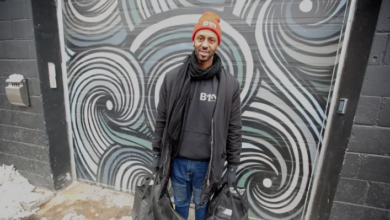The problem with Ontario’s plan to ban food waste from landfills
Ontario has ambitious plans to ban all organic waste from landfills by 2022, but the province has not said how it will handle all of the additional compost.
“We’re going to run out of room,” said Mike Chopowick, Ontario’s waste management director. “The No. 1 issue is going to be capacity. Ontario produces a lot of waste.”
The province launched its food and organic waste framework in 2017.
Food thrown in the trash rather than the green bin has a significant environmental impact. When it reaches the landfill and starts decomposing, it releases methane — a gas that is estimated to be about 25 times more potent than carbon dioxide over a 100-year span.
It also contaminates the ground and water with leachate, the liquid that leaks from landfill trash, and wastes any potential for reuse.
Ontario will be the third province to ban organic waste in landfills, following Nova Scotia and P.E.I.
In 2015, Ontario’s restaurants, residents, retail outlets and farmers generated about 3.7 million tonnes of food and organic waste. Much of it was food that could have been eaten or reused, the authors of the framework found. About 60 per cent of that waste was sent to landfill instead of organic waste facilities.
Dianne Saxe, president of the green consultancy Saxe Facts and Ontario’s former environmental commissioner, says the province’s political leaders must boost the capacity of Ontario’s composting facilities ahead of the ban.
“Part of the effort to get organic waste out of the landfill has to fall on the government,” she said. “They have to make it possible to make facilities. If we had a ban [on food in the landfill] tomorrow, where would it all go?”
Lessons from other provinces
Nearly two decades after Nova Scotia implemented its ban in 1998, about half of the province’s landfill trash was still organic waste.
What’s more, Nova Scotia’s composting facilities contained towering piles of compost — so much that it could not be composted fast enough. The materials have to be run once or twice through the composting steps as a result. And even then, no one wanted to buy the soil that resulted from it.
The piles were becoming too contaminated with plastics, glass and other non-organic items. Facilities were finding just about everything in the organic waste — including tires, underwear, clothes, forks, and plates.
Farmers were unwilling to take the end product off the city’s hands, even for free, because they weren’t sold on the quality.
Vancouver, which banned food waste in 2015, was able to cut the amount of organic waste going into the landfill in the first year by only 22 per cent. The city eased in its ban, with inspectors targeting only loads with more than 25 per cent visible food waste and issuing surcharges.
Canadians waste a lot of food
Ontario similarly plans to phase in its ban.
Rather than boosting composting capacity, the province’s goal is to attempt to reduce and reuse waste by working with government, producers, and consumers to raise awareness about how we consume.
That’s going to take some doing. Communities across Canada waste a lot.
More than half of the food produced is thrown away, according to a study by Second Harvest, a Toronto-based group working to reduce food waste. According to that study, 32 per cent of food wasted is perfectly edible.
“Apples rot under trees due to labour shortages or low prices, making it uneconomical for farmers to harvest,” the Second Harvest report said.
“Surplus milk flows into sewers. Thousands of acres of produce are plowed under due to cancelled orders. Fish are caught, then tossed back into the water to die if they don’t match the quota.”
Solutions beyond composting
It’s even worse when retail outlets and consumers throw food in the garbage, said Paul van der Werf, an environmental consultant and food waste researcher at Western University in London.
“Because we live in a country with so much available to us, people don’t link what they buy to what they’re going to use,” he said.
“They don’t think about the food they’re going to waste because they can always say, ‘Oh well, I’ll just buy some more.’ It’s all about tweaking behaviours like these.”
Much of this waste is entirely avoidable, says Saxe, and Canada should be looking at solutions beyond composting.
“There is a hierarchy of things that can be done with food waste, landfill being the worst, of course,” she said. “The first being feed other people [and] the second being to feed animals. And if neither of those is possible, turn it into compost.”
In Canada, there is a law that protects against liability if your donated food makes someone sick, and many organizations accept food that could be past the best before date, which generally signal a decrease in quality, not an expiration.
Saxe says it comes down to innovative thinking.
At buffets in Germany, extra food is sold in large buckets for cheap at the end of the night. Companies across Canada and the United States will take unsold and uneaten food and feed it to the hungry. Grocery stores in France are banned from throwing out ugly or unsold food.
“Initiatives like these help mitigate food waste and doesn’t cost anything to do,” Saxe said. “This is the kind of thinking we need to get rid of food waste.”






Redes Sociais - Comentários